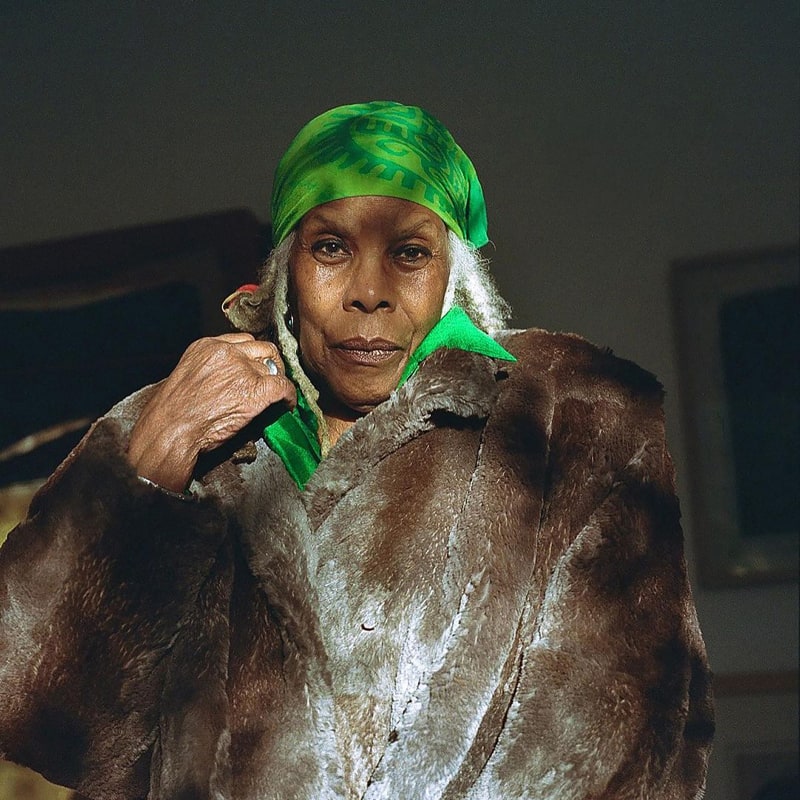A dynamic force in American painting since the 1960s, Mary Lovelace O’Neal (b. 1942; Jackson, MS) has developed a singular visual language that is acutely personal and profoundly political. Drawing on a broad range of influences—from Minimalism to Abstract Expressionism—Lovelace O’Neal’s practice is at once worldly, parsing social themes of race and gender, and philosophical, fully immersed in conceptual and metaphysical investigations of joy, exuberance, nature, and the sublime.
Throughout her 60-year career, Lovelace O’Neal has produced a remarkable body of work—including paintings, prints, and drawings—that reconciles the intimate and the monumental, the minimalist and the expressionist, personal narrative and collective mythology. Often working on a grand scale, Lovelace O’Neal is renowned for her keen sensitivity to color and unexpected use of materials. Her practice moves fluidly between figuration and abstraction: the suggestion of architecture and figures often lurk just beneath her vivid, painterly surfaces. The enigmatic, often inscrutable titles of her paintings hint opaquely at a narrative embedded within the work that is never fully revealed.
The formal vitality of Lovelace O’Neal’s practice is inextricable from its social, political, and historical urgency. Although she never worked in the narrative and figurative styles favored by many artists associated with the Black Arts Movement—in fact, quite the opposite—Lovelace O’Neal’s practice nevertheless speaks to her experience as a Black woman and reflects her desire to express these experiences in visual language. Lovelace O’Neal earned a BFA at Howard University, where she studied with influential Black artists and art historians David C. Driskell, Loïs Mailou Jones, and James A. Porter. She was active in the civil rights movement, traveling to Mississippi to support voter registration drives, labor protests, and marches with fellow Howard student Stokely Carmichael.
In 1969, Lovelace O’Neal earned an MFA from Columbia University, studying under Stephen Greene; it was while she was a student at Columbia that she began working with lampblack. Applying the loose powder pigment to unstretched canvas with a chalkboard eraser, Lovelace O’Neal produced a flat, velvety black surface. Lampblack became her response to Minimalism, which had always been in conflict with an expressionistic impulse in her work. With lampblack, Lovelace O’Neal achieved the flatness Minimalism aspired to while maintaining a remarkable sense of depth—using underdrawings and thin lines of acrylic, pastel, oil, or masking tape. For Lovelace O’Neal, the blackness of these works also spoke to her experience as a Black woman: “my painting...answered the social question of Blackness,” Lovelace O’Neal says, “and it also answered the theoretical question about Black painting.”
After graduating from Columbia, Lovelace O’Neal moved to San Francisco—away from New York and away from Minimalism—finding inspiration instead in the sights and sounds of California. “I went to the aquarium once and saw whales mating,” she says. “Then I saw them swimming in the bay. It was magic. God’s work. It was transformative. I painted it.” The resulting series, Whales Fucking, is gestural and expressionistic, sensual and dynamic. Lovelace O’Neal’s extensive international travels—frequently with husband Patricio Moreno Toro—informed her practice throughout the 1980s and 1990s. In the early 1980s, she joined Robert Blackburn’s New York printmaking workshop. In 1989, she completed an artist residency in Morocco and joined Taller 99, a communal print workshop in Santiago, Chile organized by Nemesio Antúnez. Figurative and representational elements, often inspired by her travels, appear within the energetic brushwork and dynamic colors of her work during this period—whales and panthers, palaces and fruit-laden tables—lurking just beneath her abstract surfaces.
Since retiring from teaching in 2006, Lovelace O’Neal has spent much of her time in Mérida, Mexico. Between 2021 and 2023, Lovelace O’Neal produced an entirely new body of work, The Mexico Works. Throughout these monumental canvases, the artist borrows extensively from imagery she has developed over the course of her career. From velvety black surfaces —reminiscent of her lampblack works—sensuous gestures, anthropomorphic figures, and hints of architecture spring forth with theatrical vigor found throughout her work from the 1980s, 1990s, and early 2000s.
Lovelace O’Neal’s work has been the subject of solo exhibitions at the San Francisco Museum of Modern Art, CA; the Cité International des Arts, Paris; and the Mississippi Museum of Art, Jackson, MS. Lovelace O’Neal was presented the Artiste in France award from the French government in 1993; following the six-month residency, her work was the subject of a solo exhibition at the Cité International des Arts in Paris, which traveled to the French Embassy in New York. Her work has been featured in exhibitions at the California African American Museum, Los Angeles, CA; the National Museum of Women in the Arts, Washington, D.C.; the Brooklyn Museum, NY; the Baltimore Museum of Art, MD; and the St. Louis Art Museum, MO, among others. A monumental work from Lovelace O’Neal’s early Lampblack series was the subject of a 2022 Art Basel Unlimited presentation with Jenkins Johnson Gallery. Her work is in the permanent collections of the Art Institute of Chicago, IL; the National Gallery of Art, Washington, D.C.; the de Young Museum, San Francisco, CA; the San Francisco Museum of Modern Art, CA; the Smithsonian Institutions, Washington, D.C., the Brooklyn Museum, NY; the Baltimore Museum of Art, MD; the Mott-Warsh Collection, Flint, MI; and the National Museum of Fine Arts, Santiago, Chile, among others. Lovelace O’Neal earned a BFA from Howard University in 1964 and an MFA from Columbia University in 1969. Beginning in the late 1970s, Lovelace O’Neal taught in the Department of Art Practice at the University of California, Berkeley; she was awarded tenure in 1985, and later served as chair of the department. She retired from teaching in 2006 and has since been Professor Emeritus. Lovelace O’Neal lives and works in Oakland, CA, and Mérida, Yucatán, Mexico.

